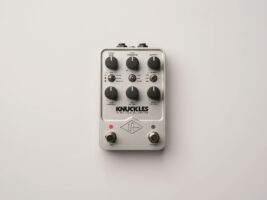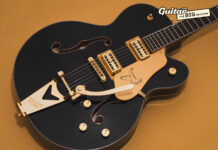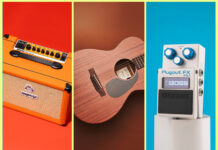
Universal Audio UAFX Knuckles review – the perfect high-gain pedal amp?
$399/£379, uaudio.com
For much of the last 20 years the default situation – especially in guitar circles – has been to sneer at any music produced by someone who might have worn shorts and a wallet chain onstage. But for all the snobbery around a lot of the popular guitar music of the late 20th and early 21st Centuries – especially pop-punk and nu-metal – the reality is that this music has proved to be hugely influential on an entire generation of musicians.
READ MORE: Universal Audio UAFX ANTI review: is this 5150 emulation a full metal rig in one pedal?
From Finneas to Olivia Rodrigo, Fontaines D.C. to Phoebe Bridgers, it’s rare we speak to an artist under the age of 30 here at Guitar.com that doesn’t have an origin story involving some combination Blink-182, Green Day, Korn, System Of A Down, and what have you. Gen Z has clearly cottoned on to this too, bringing the sounds and aesthetics of the Millenium era – crappy digital cameras and all – into the zeitgeist once again.
All of which is to say that the Mesa/Boogie Dual Rectifier is having something of a moment again – because they have a distinct sound that was once all-encompassing in guitar music, but now feels retro and authentically of a time and place. Hell, David Knudson – of briefly and gloriously reformed hardcore heroes Botch – even went to the bother of tracking his original Dual Rec to play their reunion tour, because sometimes you need an amp that’s so 90s, the front is made of metal treadplate. The only way it could be more of its time is if it had a tribal tattoo somewhere on its person.
Which brings me to this – the Knuckles. UAFX’s latest amp pedal that promises to bring every wonderful flavour of Dual Rectifier amplifier into its popular floor-based-amp format.
Image: Press
What is the UAFX Knuckles?
In the now familiar style of its amp-in-a-box pedals, the Knuckles aims to distil the magic of a 1992 Mesa/Boogie Dual Rectifier into a pedal slightly wider and slightly larger than a standard compact pedal.
As with the rest of the range you get six knobs, three toggle switches and a pair of footswitches to control the various functions, with stereo in and outs up top, plus a barrel power socket and USB-C for firmware updates. The Knuckles is either meant to be used direct for recording or gigging purposes, and it has the limited functionality for home use that we’ve come to expect from the range – there’s no headphone out for quiet practice, and you’re going to want to run it into some sort of powered cab or audio interface before recording it.
With the aid of the UAFX Control app and a cooperative Bluetooth connection you can tweak all manner of things about the amp under the hood, including choosing from a vintage or more modern channel voicing for each of the three channels, the type of rectification used, the power tubes the amp is cooking with and even the type of power the amp is getting.
As with the UAFX Anti, the Knuckles also doesn’t just emulate the amp on its own, but also gives you the sound of a Tube Screamer (or a solid-state preamp) running directly in front of it to give your Rectifier sounds even more punch. There’s also a noise gate for those who enjoy the Dual Rec’s more extreme settings.
Handily, we also get a bunch of presets on board – including factory ones from UA, and a gaggle of artist-made ones from The Black Dahlia Murder and Between The Buried And Me, heavy producer extraordinaire Romesh Dodangoda, and Green Day engineer Chris Dugan.
Image: Press
Is the UAFX Knuckles easy to use?
If you’ve read a review of a UAFX pedal before, you’re probably really, really bored of reading about the mobile app, and friends, I am also bored of this. Unfortunately, it’s still a huge problem.
Upon booting up the Knuckles, I downloaded the UAFX app and attempted to connect it to my iPhone 14 Pro Max, and for a second it looked like everything was going to go smoothly. The Knuckles appeared on the app’s main screen and I tapped it to connect… and nothing.
Maybe a firmware update is required I thought… but of course, in order to update the firmware, you have to go onto your computer, download a different app, and update it via the USB-C. Having done that, I was then able to use the different app on my phone to connect to the pedal and access the fairly substantial deep-editing features and artist presets that are only available when you connect to said pedal by Bluetooth.
Having last had to grapple with the UAFX app a year or so back when we were looking at the second tranche of big-box UAFX effects, I’m relieved to say that it is better than it used to be. The connection is still prone to dropping out, and will require a 30-second reconnect every time you leave your phone long enough to lock it – every time! – but by and large when I wanted it to be connected, it would do so.
Image: Press
But guys, that is a really low bar here in 2024. This is a world where Fender can give me a full and completely intuitive app-based amp and effects experience in a $100 pocket amp, where apps from Neural DSP and Positive Grid work seamlessly and flawlessly every single time, even doing over-the-air firmware updates. Meanwhile, this $399 amp pedal needs me to download two different apps on two different devices to do the same thing in a less consistent and enjoyable way. And there’s no bloody headphone out.
It’s abundantly clear now that UA is wedded to this user-unfriendly system for whatever mad reason that might be – we’re too far down the UAFX road to expect any meaningful change at this point – but man, it still sucks, and people like me reviewing these things should not stop talking about it until such a time as it doesn’t.
The good news is that you don’t have to engage too much with the app if you don’t want to – you can tweak the channel, the cab choice, and the basic amp settings with the knobs on the pedal itself. However, if you want to get the most out of it – explore the different flavours of rectification and valve choice, or get that Tube Screamer out of the equation for example – you’ll need the app to work and work consistently.
Is the UAFX Knuckles well made?
As with previous UAFX pedals, this absolutely feels as expensive as it undoubtedly is. The metal chassis is sumptuous and powder-coated, the travel of the bespoke knobs is smooth and firm – making it almost impossible to knock accidentally – while the soft-touch footswitches are rugged and reassuring.
The only thing that perhaps isn’t as reassuring is the choice to use plastic jack plugs. It’s been a feature of all of UA’s pedals, and while this might just be splitting hairs given that I’ve never known anyone to have an issue with them, they don’t seem as reassuring as a standard metal jack would. I did wonder if it was a decision made based on heat transfer (the Knuckles can get a little warm after running for a while) or perhaps even wireless connectivity? If they are trying to put less metal in that area to remove things that might interfere with the signal, it’s not exactly working brilliantly…
Image: Press
Does the UAFX Knuckles sound good?
This always seems to be the kicker with all of the UAFX amp pedals. The issues with some of the basic functionality are consistently a problem, but once you’ve gotten over the half an hour of frustration that inevitably comes with setting them up, the sounds, man. The sounds are so good.
As someone who cut his guitar teeth playing in shitty punk bands around the turn of the Millennium, the cultural touchstones the Knuckles evokes here are myriad and wonderful. Pretty much every modelling amp, software or multi-effects unit will have some sort of ‘Dual Rectifier’ setting on it, and if that’s your primary experience of the sound, I beg of you – reset your ears and brain.
Pretty much all the Rec-alikes you find in modelling software are trying to do the most extreme, saturated kind of sound that made (and continues to make) the amp such a success with metal players. Honestly though, that’s like using an iPhone as an egg timer – it does a very good job of it, but there’s a lot more to explore here.
Mesa amps were originally prized for their crystalline high-headroom clean tones, and while the Knuckles is definitely not a Mk I, it can certainly offer punchy filth-free sounds with the Tube Screamer off and the gain turned down on the clean channel. Even in this form, however, you get the sense that it’s a caged animal, never more than an overzealous downpick or hasty strum away from blooming into crunch. The pedal’s room control is a nice addition here, however – adding genuine ‘amp in the room’ character to these more polite and genteel sounds.
Switching over to the Orange channel however, is where things start to get more familiar – scoop out those midrange frequencies and beef up the gain and you’ve got a quick route to those classic 90s nu-metal tones, with the Knuckles’ natural low-end punch being accentuated even further by dropping things down, tuning wise. There’s still a real bark in the high end here however, and that’s something that very few Rec-alikes really get right – that blend of power and clarity is what makes this such a versatile rock monster.
The Orange channel is where you’ll find those taught punk chugs, or the big, wide-open Foo Fighters rhythm tones – it’s a hugely impressive recreation of the real thing, and probably the best pure recreation of that Rec tone I’ve heard. I A/B’d the Knuckles through a FRFR speaker against Neural’s Nano Cortex using a studio-captured Dual Rec, and while it was a very close thing, the UA just sounds a little bit more like a real amp to me. And obviously with far more versatility.
If you want to get truly silly on the gain front, the Red channel has all the dirt you could ever need and more. If you want to occupy as many frequencies as possible while still having punch and power and clarity in that Meshuggah-y kinda way, this is for you.
Universal Audio UAFX Knuckles – should I buy one?
The caveats that apply to the entire UAFX amp pedal line-up are still present and correct with the Knuckles. Without a headphone or digital recording out, you’re limited to using this either direct into your PA/audio interface, or running into a FRFR cab. Comparatively, there are many other pedal amp options that offer a much broader use case than this does and do it for a more reasonable price too.
As with the rest of the UAFX amp pedal range, the thing that you can’t get away from is the sound. The Knuckles is the best emulation of a Dual Rectifier I’ve ever heard, and one that beats every other profile and model you can find on any of the other high-end modellers and amp pedals out there.
The question is whether that’s enough – we’re over two years into the life cycle of this family of products now, and it seems readily apparent that UA are unwilling or unable to fix the significant issues that users have been reporting since 2022. Unlike say, Neural DSP, that has a proven track record of adding features and tweaking significant things over the course of a product’s lifespan, we’re probably at a point where we have to just accept that this is what these pedals are now, for good or for ill.
Is that good enough? I think it depends on what you really need this pedal for, but if you prize quality of sound above anything else, you simply won’t find anything better.
UAFX Knuckles alternatives
The elephant in the room here is Neural DSP’s Nano Cortex ($549/£499), which offers the Quad Cortex’s hugely impressive real amp capture library in a much more compact package. If you’re after an affordable and rock-ready pedal amp that doesn’t trouble itself with bells and whistles then Orange’s Terror Stamp ($199/£159) offers 20 watts of British fun. If you wanna get loud however, the Laney Ironheart Loudpedal ($499/£299) is a 60-watt heavy metal beast.
The post Universal Audio UAFX Knuckles review – the perfect high-gain pedal amp? appeared first on Guitar.com | All Things Guitar.
Source: www.guitar-bass.net













